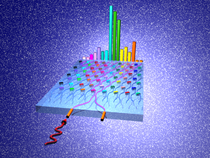First predicted for quantum particles in the presence of a disordered potential, Anderson localization is a ubiquitous effect, observed also in classical systems, arising from the destructive interference of waves propagating in static disordered media. Here we report the observation of this phenomenon for pairs of polarization-entangled photons in a discrete quantum walk affected by position-dependent disorder. By exploiting polarization entanglement of photons to simulate different quantum statistics, we experimentally investigate the interplay between the Anderson localization mechanism and the bosonic/fermionic symmetry of the wavefunction. The disordered lattice is realized by an integrated array of interferometers fabricated in glass by femtosecond laser writing. A novel technique is used to introduce a controlled phase shift into each unit mesh of the network. This approach yields great potential for quantum simulation and for implementing a computational power beyond the one of a classical computer in the ‘hard-to-simulate’ scenario.
A. Crespi, R. Osellame, R. Ramponi, V. Giovannetti, R. Fazio, L. Sansoni, F. De Nicola, F. Sciarrino, and P. Mataloni, Anderson localization of entangled photons in an integrated quantum walk, Nature Photonics 7, 322–328 (2013) doi:10.1038/nphoton.2013.26.

